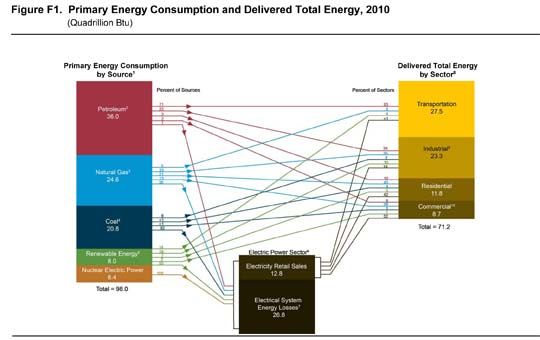The Annual Energy Review 2010 has more than 400 pages, all chock-full of the latest information on energy trends in the U.S. The report, produced by the U.S. Energy Information Administration, notes the increasing presence of renewables in a series of graphs and charts. It is a sign that renewables are statistically significant enough in numbers (outside of hydro) to necessitate inclusion.
Many of the trends are not surprising, although one colorful graph that shows a yellow line reaching far past the others raises an eyebrow.
The graph shows total energy consumption by energy source for U.S. residential and commercial sectors. The line, however, does not represent the increased use of electricity to plug in everything from iPads to LCD TVs, nor does it show the increase in natural gas production. Rather, it illustrates electrical losses defined as energy losses associated with the generation, transmission and distribution of electricity.

And just how much energy are we talking about? At least about 20 quadrillion Btu and perhaps even as much as 26.8 quadrillion Btu, if you consult another figure that also appears in the same report. While much of that loss is “a thermodynamically necessary feature of the steam-electric cycle,” according to the EIA, it is still more than double the amount of electricity that is sold in the U.S. each year.
According to the EIA, about seven percent of that is lost in transmission and distribution (largely in distribution, if you ask anyone in the industry) and another five percent is gobbled up in power plant use. It’s no secret that losses along the U.S. electrical grid are substantial; many utilities are addressing some of those losses through distribution automation projects.

The data from the EIA, however, shows that there are opportunities beyond the distribution circuits. A good deal of that energy will always be lost in conversion, but better engineering both inside and outside of power plants could save quadrillions of Btu annually.
The first graph shows that while some consumption is relatively flat or ticking up, nothing is growing nearly as fast as the amount that is lost each year. Even electricity consumption is not growing at a rate that is equal to that figure.
The reasons for this growing gap are many, but the bulk of the problem is tied to outdated regulatory models for utilities. Many a utility shareholder might ask, who cares about efficiency if no one gets paid for it? Decoupling and other incentives, such as EPA regulations that will shut down the dirtiest (and many of the oldest) coal-fired power plants are two steps that will help to address the issue.
But even more solutions are needed. Startups are entering the fray with new technologies to capture waste heat. However, before these technologies can take off, regulators need to create value in energy conservation and recovery, and not just production.



